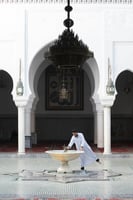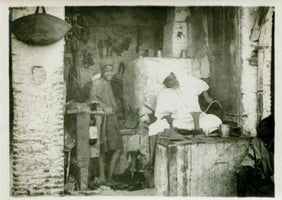Mohammed Hamdouni, a researcher in anthropology, reflects on his own encounter with the space of...
The Sacred Soundscape of Fez: Listening as Spiritual Practice

Fez is not only a city of walls, gates, and minarets—it is a city of sound. In its densely layered medina, listening becomes an act of immersion, orientation, and even devotion. The sacred soundscape of Fez is not a backdrop to spiritual life; it is a central medium through which the sacred becomes knowable, felt, and embodied.
The Daily Pulse: Qur'anic Recitation in the Medina
Each morning in Fez begins not with silence, but with sacred rhythm. The sound of Qur’anic recitations flowing from shopfronts, homes, and riads gives the medina its pulse. Unlike the solitary consumption of spiritual texts common in Western contexts, here sacred knowledge is shared aloud, publicly, and communally. It serves as both invocation and orientation—a way of reordering space and time in relation to the divine.
For many local residents, the recitation is not merely religious practice but part of a larger cosmology of sound. It creates a living atmosphere where spiritual memory is renewed daily and the sonic presence of the divine coexists with the sounds of the marketplace.
Ritual and Rhythm: The Gnawa Lila
The Gnawa Lila—an all-night spiritual ritual performed by the Gnawa community—marks another layer of Fez’s sacred sonic map. Blending sub-Saharan rhythms with Islamic invocation, the Lila is at once healing, ancestral, and cosmological. Through the hypnotic pulse of the guembri, the clash of krakebs, and the call-and-response of sacred names, the Gnawa Lila creates a sonic structure designed to lead participants into altered states of consciousness.
In this context, rhythm is theology. It is not ornamental to the ritual but the mode through which knowledge is transmitted. For participants in the lila, to listen is to be drawn in—to the self, the community, and the unseen.
Echoes of the Hadra: Sufi Chant and Trance
Another sound central to Fez’s spiritual environment is the Hadra—the collective invocation practiced by Sufi communities. Unlike the performative or aesthetic role of music in other contexts, the Hadra in Fez functions as a disciplined opening to divine presence. The rhythmic repetition of sacred names, often in tight harmony, produces a group field of resonance that transcends language.
This resonance is spatial as well as emotional. The architecture of Fez’s zawiyas, with their domes and tiled courtyards, becomes a chamber for spiritual sound—where devotion echoes and returns. In these moments, the city’s architecture and its acoustic theology merge.
Listening as Embodied Knowledge
Fez teaches us that listening is not passive reception but an embodied epistemology. Sound in this sacred context is not simply heard; it is absorbed, mirrored in gesture, breath, and inner rhythm. To walk through the medina, to attend a lila, to sit within the cadence of a Sufi chant—is to participate in a form of embodied knowing that transcends didactic teaching.
For participants in the Wissal 2025 Retreat, listening becomes a spiritual practice in itself. Whether through the gentle verses of dawn, the polyrhythmic trance of a Gnawa ritual, or the collective breath of a Sufi circle, the soundscape of Fez offers a rare opportunity to inhabit spirituality with the full body.



